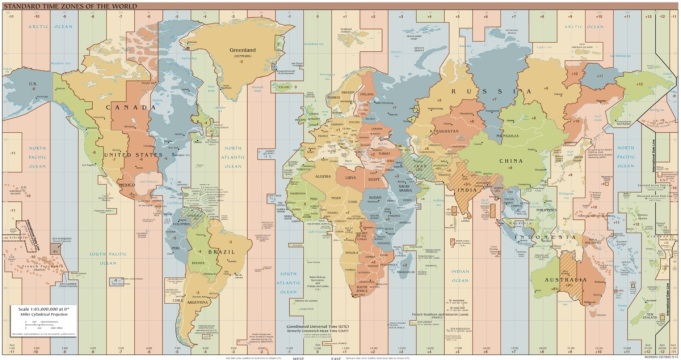On June 30 2015 an extra second will be inserted into the very end of the day. This extra second is called a leap second.
Why do we need leap seconds?
Although we take the average length of a day to be 24 hours, the mean solar day, or average “natural” day measured by the Earth’s rotation is now slightly longer than this. This is actually due to the slowing of the Earth’s rotation. See Note 1. At this present time, in the early 21st century, it is actually around 24 hours 0.001 seconds. So, to bring the day measured by accurate atomic clocks in line with the natural day, a leap second needs to be added approximately every 1,000 days. These leap seconds have always been added at the end of the day on June 30 or December 31. The previous one was added on June 30 2012.
Problems with leap seconds
It has been possible for around two hundred years to accurately measure the rotation of the Earth, and it is now clear that it is slowing down, which means that the length of the mean solar day is increasing. However, over shorter timescales things aren’t quite as simple as this. The actual speed of the Earth’s rotation is variable and events such as
- large earthquakes
- movements in the Earth’s crust
- melting of glaciers
- changes in the mantle (the region of the Earth below the crust)
may temporarily speed it up.
The diagram above shows the amount by which the average length of a day was longer than 24 hours, measured in milliseconds, for the years 2000 to 2014. 1 millisecond equals one thousandth of a second.
This variation means that, unlike leap years, where there are precise rules for determining whether or not a given year will be a leap year, it is not possible to say years in advance when there will be a leap second. A body called the International Earth Rotation and Reference Systems Service (www.iers.org) decides from accurate measurements of the Earth’s rotation when the next leap second will occur.
This announcement can only be made around six months in advance. For example, the official announcement of the June 30 leap second was made on January 5 2015 by the following bulletin.
When the last leap second was added back in 2012, a number of data centres and websites around the world experienced system problems and crashed. This was because they did not allow for 61 second minutes and interpreted this unforeseen event as a system failure. It is likely that many other sites will experience similar problems this time round. To minimise the risk many U.S. stock exchanges including the New York Stock Exchange will close early to reduce the impact of any potential problem (Ref 1).
Another approach to the problem
Amazon are using an interesting solution to the problem. For the 24 hour period from 12 noon on June 30 to 12 noon on July 1 Amazon will abolish the normal rules of timekeeping. Instead of normal seconds, they will be using an “Amazon Second” which is fractionally longer than the usual second. Instead of adding an extra second just before midnight like everyone else, they are spreading out that extra second throughout the entire day which means that no extra second will be need to be inserted. This is shown in the diagram below:
There are normally 86,400 seconds in day, but in the 24 hour period which has a leap second there will be 86,401. By using slightly longer seconds Amazon avoids having to add a leap second, but this means that its computers will be up to half a second out from GMT between 12:00 on June 30(A) and 12:00 July 1(B).
For more details see ref 2.
What will happen in the longer term ?
As the length of the day gradually increases time, the frequency of leap seconds will need to increase. In 100 years time we will have, on average, a leap second once a year and in 1,000 years time we will have 7 leap seconds per year.
When will the leap second be added?
The extra second is inserted at 23:59:60 at 30 June 2015, Greenwich Mean Time (GMT). As Greenwich – and everywhere else in the UK – will be operating on British Summer Time (BST), the extra second will actually be inserted just before 1am on the morning of 1 July. New York is 4 hours behind GMT, so the extra second will be added at 19:59:60 on 30 June, and in Beijing, 8 hours ahead of GMT, the extra second will be added at 07:59:60 on 1 July.
Notes
1)The average length of day when calculated over a entire year is just over 24 hours. However, over the course of a year the the actual length of a solar day varies. This variation throughout the year is due to entirely different effects than the slowing of the Earth’s rotation. It is at its longest – 24 hours and 30 seconds – around Christmas day and it is shortest at around 23 hours 59 minutes and 38 seconds in mid September. This is variation is described in more detail in my post 12 Feb 2015: A special day.
2) The term Greenwich Mean Time is no longer used by astronomers. It is ambiguous, as you will see below. Instead, astronomers use two different times which agree with each other to within 1 second.
Universal Time, often abbreviated to UT1, is the mean solar time, the time determined by the rising and setting of the Sun at the Greenwich Meridian, zero degrees longitude.
Co-ordinated Universal Time, usually abbreviated to UTC, is the time measured by atomic clocks and is kept to within 1 second of UT1 by the addition of leap seconds.
In common use, Greenwich Mean Time (GMT) is often taken to be the same as UTC , which is the approach I have taken for this post. However, it can also be taken to mean UT1. Owing to the ambiguity of whether UTC or UT1 is meant, and because timekeeping laws usually refer to UTC, GMT is normally avoided in precise writing.
The Greenwich Meridian- Image from Wikimedia Commons (Daniel Case)
References
(1) http://www.nasdaq.com/article/markets-are-jumpy-over-coming-leap-second-20150518-01174
(2) http://www.zdnet.com/article/amazon-find-its-own-way-around-leap-second-problem-by-skewing-time-instead/








[…] rotation speed does vary and is gradually slowing down, as described in my previous post on leap seconds, the effects are very small and unpredictable. In fact the time for the Earth to turn once on its […]
LikeLike
Nice discussion
LikeLike
THank you
The Science Geek
LikeLike
Thank you for this. As a homeschooling father, this filled an important need and I’ll definitely be making use of your excellent blog in the future.
Any extra time will be added to the kids’ schoolday!
LikeLike
Reblogged this on Wise the Simple and commented:
Happy Leap Second Day, everyone! Here’s hoping our computers don’t freak out 🙂
LikeLike
[…] by design. I expect you all to be extra productive today! […]
LikeLike
Wow..Something new to learn…leap second!
LikeLike
Reblogged this on The End Justifies the Journey and commented:
What a comprehensive and interesting writeup!
LikeLike
Thanks for the reblog
The Science Geek
LikeLiked by 1 person
Reblogging. Hope you won’t mind.
LikeLike
I had read about leap seconds somewhere long ago. I will think of this post on June 30! Thanks for stopping by my humble blog!
LikeLike
I didn’t know anything about leap seconds until I read this, and it was easy to understand. Thanks for writing it!
LikeLike
Thank you,
glad you enjoyed reading the post.
The Science Geek
LikeLiked by 1 person
Reblogged this on msamba.
LikeLike
To be completely clear, GMT does not have leap seconds, and it never did, but then again, there is no authority who defines the meaning and implementation of GMT. UTC has had leap seconds since 1972 according to the authority of the ITU-R (originally CCIR) and the implementation is handled by IERS (originally BIH). Except that UTC does not have leap seconds if it is being handled according to POSIX rules. Therein we have two international standards in disagreement with each other , which is what evokes problems.
LikeLike
Hi Steve
Thank you for your interesting comment. I have had a good look at the website:
http://www.ucolick.org/~sla/leapsecs/ and there is some interesting content there.
Of course, you are correct in the sense that, strictly speaking, I should have used the term Co-ordinated Universal (UTC) time in this post rather than GMT, but I decided to use GMT rather than UTC as this is the term more widely used by non astronomers.
I have amended the post to put a short note at the end to explain this.
The Science Geek
LikeLike
Fascinating post.
LikeLike
Wow, this was a fascinating post. Upon reflection, it makes sense that there would be some variability in the time the earth takes to rotate, but I’d never thought about it before.
LikeLike
Thanks
LikeLike
Fascinating. But, let me ask, is your subjective experience of the passage of time in the opposite direction? I mean does there now seem to be less time in a day than there was when one was a child? If so, is that because as each year passes, a year is a smaller fraction of life so far, or is there some other explanation, such as the pace of life with instant communication and the digital world stimulates certain frequencies in brainwave. Do you have a view on this?
LikeLike
Hi Colin,
Glad you enjoyed my post. I know many people have said to me that as they get older time appears to pass more quickly. I personally don’t find this to be the case. There was an interesting article about this on the BBC website
http://www.bbc.com/future/story/20120709-does-life-speed-up-as-you-age
The Science Geek
LikeLike
[…] thought this account of how leap seconds work at “The Science Geek” was outstanding. A complex subject explained in English that you can understand, without […]
LikeLike
If I may say, I thought this was an excellent accesible account of how leap seconds work. It’s not easy to blend solid science and readability! I will attempt to post a link on my FB page.
Do let me know if you ever write anything about telomeres and ageing as this is a key theme of my sci-fi novel Biotime.
LikeLike
Thank you Robert
The Science Geek
LikeLike
Robert,
Google Dr. Al Sears. He has the latest on telomeres and is probably one of the best sources for understanding human aging.
LikeLike
Time is endlessly fascinating.
LikeLike
A timeless fascination perhaps? 🙂
LikeLiked by 1 person